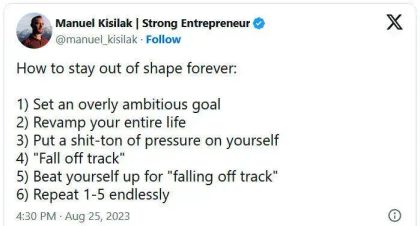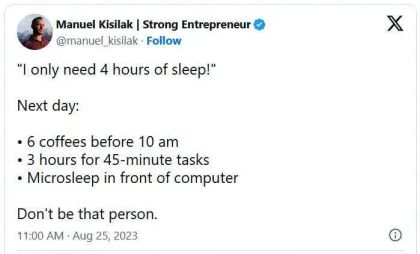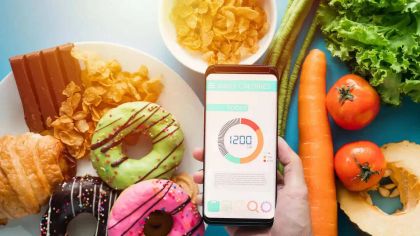Picture this:
You're on a diet, counting calories like a mad scientist, and it's working great. You're losing weight, getting stronger, and feeling awesome. But then, it starts to suck the joy out of eating:
- You get tired of turning your meals into math problems.
- You eat stuff you don't even like, just to hit your calorie goal.
- You dread the business dinner scheduled at a restaurant that doesn't show specific calories for each meal.
- You want to take the invite to the birthday party, but you don't want to sit there with a calculator.
- You can't wait to ditch the calorie counting once you hit your goal weight.
If that's you, I can relate. I've been through the same from 2018 until 2020. And it took me over a year to be able to enjoy food again.
Here’s the truth:
Unless you’re a competitive athlete, this isn’t the best way to build a strong and lean body. There’s a better way to achieve that goal without following a rigid meal plan or diet 100% of the time:
The Food Freedom Method.
This plan won't make you count every bite you eat, yet it gets you lasting and steady results while enjoying your meals.
Read to discover how to get your dream body without the pain of counting calories or following strict diets.
The journey to food freedom

To understand the Food Freedom Framework, let’s look at the journey someone usually goes through when they just start to work towards their goal. We can divide it into four stages:
1) Deprived Stage
During a busy day, you glance at the mirror and you’re not happy about what you see. You know that something has to change, but you don’t know how. Doubt creeps in. You might wonder if you're just not cut out for fitness changes because of your tight schedule.
This doubt leads to procrastination, putting off taking action. Once you decide to take action, it’s erratic:
It’s the stage where you’re susceptible to flashy ads for a "3-Day Detox Cleanse" or “4-Week-Weightloss Challenges” that promise you to cut 20 lbs and turn you into the fitness model on the ad cover in no time. You decide to cut carbs one day, eat only salads the next, and then try a high-intensity workout you found online.
The lack of a clear plan leaves you feeling like you're throwing spaghetti at the wall, hoping something sticks.
2) Yoyo Stage
After your initial failures, you start to self-educate. You're sitting at your desk, scrolling through conflicting advice on weight loss and muscle building, trying to make sense of it.
Despite your commitment to change, you're frustrated because you feel like you're in a maze of information. You have no idea what to make off of all the diets, workout plans, or supplements suggested by different sources. You're not sure which advice fits into your schedule and suits your specific needs.
You start hitting the gym, and you even get a few personal training sessions. It feels good to take action toward your fitness goals.
But, you’re still inconsistent with your work and make a lot of beginner mistakes:
- Hopping around between different training programs every two weeks.
- Jumping into overly strict diets that promise you quick and easy results.
- Neglecting the importance of recovery, sleep, and stress management.
You might lose some weight, then regain it, and the cycle continues. The sad reality is that most people stay stuck here forever.
3) All-or-nothing Stage
This is the stage where most of the fitness industry is right now. Here, it's not about trying out random workouts and diets anymore. You're ready to commit for the long haul and learned the lessons:
Breaking free from the yo-yo cycle requires structure. So you start following a well-organized plan that aligns with your goals:
- Working out 2-4 times a week is non-negotiable.
- You follow a strict meal plan or you count your calories.
- You even start getting to bed early and catch 8 hours of sleep.
The efforts pay off. You start losing weight and manage to keep it off. You're no longer stuck in the cycle of losing and regaining pounds.
But, this stage isn’t all sunshine and rainbows - it’s a grind: Weighing your meals is exhausting after a long day of work. On your family vacation, you get anxious about finding restaurants that fit your needs. You’re tired of coworkers commenting on you for running around with Tupperware containers.
It triggers you because you’d love to enjoy a meal here and there without pulling out the scale. The problem is that you've developed an all-or-nothing mindset. You fear that a step outside of your routines might ruin your progress.
If you stay at this stage for too long, you run the risk of fatiguing mentally. When that happens, you give in to some craving, which leads you down into guilt and, finally, ditching the habit - and often regaining the weight. But luckily, there’s a stage beyond that…
4) Food-Freedom
This is something most of the fitness industry doesn’t talk about: Being in great shape and still able to enjoy your food. You reach this state when fitness becomes a natural part of your life:
- You know what to eat and when.
- You wake up energized and well-rested.
- You hit your weight-loss goals sustainably.
- Doing your workouts isn't a grind anymore.
- You're aware of what triggers food cravings and how to stop it.
But unlike the All-Or-Nothing Stage, you’re calm. If you can’t go to the gym for two days, you don’t freak out. You can enjoy the family vacation without worrying about regaining weight. On a date with your partner, you feel confident about having a dessert you enjoy.
You’ve built this confidence through strong habits that allow you to make smart choices in your diet. You know what to do in every situation, even if you don’t have a scale, calculator, or app for calorie counting.
If you try to get here by trying to figure out everything yourself, it will take you at least three years. Maybe you won’t ever get here.
The good news is that you can short-cut this process through five simple steps.
Here's how you do it:
1) Recognize your eating habits
If you’re struggling to lose weight, I bet you underestimate the number of calories you consume. My new clients often realize they’ve been eating more than 1000KCal above what they thought! You have to gather data to fix that:
Start by tracking all your meals and drinks for a week. Write down what you eat without worrying about tracking calories or nutrients.
2) Optimize your meals to reduce caloric intake
Focus on whole foods that keep you satiated, such as meats, vegetables, or fruits. Cut down on processed foods such as:
- Fried meats.
- Artificial sugars.
- Calorie-laden drinks.
- Alcohol, especially hard liquor.
Make sure to include protein with every meal you eat. If this is hard for you, protein shakes provide a simple solution. Also, make sure to stay hydrated. Water reduces hunger, boosts your energy levels, and helps you focus.
3) Start strength training and move more
Yes, you can lose weight without training, but you shouldn’t. I’ve seen clients who shed belly fat just through weight training - without making any changes to their diet! Here's why it's so great:
- It helps you get rid of neck tensions and gives you a strong posture.
- More muscle means burning extra calories, even while you're sleeping.
- Being strong keeps you active for life, so you can enjoy time with your family.
You don't have to spend hours in the gym; even 2-3 workouts a week for 20-45 minutes can work wonders. Also, increase your daily activity:
Aim for 6000-8000 steps, and you'll also enjoy less stress, improved focus, and better sleep. It's like a cheat code for creative folks and busy entrepreneurs.
4) Manage your Stress and Sleep

Not doing so is a huge mistake that will ruin your dieting efforts. When you don't sleep well, it's like your body's "hunger control center" gets confused. You might start craving sugary and fatty foods, like donuts and chips. On top, you'll feel tired and sluggish during the day - something you won’t be able to make up for through caffeine. It's like trying to drive your car with an empty gas tank.
But make sure to consider stress as well. The #1 reason you eat too much junk food is often not about taste or enjoyment. It's about using it as a coping mechanism to deal with stress and discomfort.
You can have the best workout and meal plan in the world - if you sabotage yourself like that, it won’t be of value.
Learn more about how to boost your sleep - without sleeping longer HERE.
5) Collect data and adapt if necessary
You’ve started to observe your meals, habits, and activity. Now it’s time to collect data. Most make the mistake to only focus on their body weight - but that’s only one part of the picture. You can improve your looks, strength, and fitness, without seeing any changes on the scale. That’s why you need several markers:
- Weight: Weigh yourself 2-3 times per week.
- Progress pictures: Take some every two weeks.
- Waist circumference: Measure it weekly.
If you see progress in these three factors, you know you’re on the right track. Adjust your habits and meals if you don't see the results you want. Eating more protein and vegetables will usually do the job. If necessary, calculate your calorie intake for one or two weeks. You'll understand why your current approach may not be working. Don't just eat less, increase your daily steps. Tracking meals forever isn’t necessary. Over time, you'll develop the ability to eat intuitively without regaining the weight.
This is what I call "food freedom": The optimal balance between enjoyment, energy balance, and nutritiousness. You will be able to maintain your weight without tracking your meals due to the habits you have built. If your weight starts to increase for any reason, return to observing your meals to regain control.
Recap:
While you need to consider energy balance to lose weight, you don’t have to obsess over every calorie. Start by tracking your meals to collect data and get aware of your eating patterns. Get into a caloric deficit by focusing on whole foods and increasing your protein intake. Establish supportive habits such as strength training, daily activity, and quality sleep. Weigh yourself regularly to track progress and make necessary adjustments. If desired results are not achieved, reassess your habits and meals.
Within three months, you could reach a state of intuitive eating, drop 12-20 lbs in the next 90 days where you maintain your weight without constant tracking.
If that is your jam, and you’re the type of person who’s tired of trying to do all the guesswork alone and now prefers a personalized approach to help you integrate this strategy into your busy schedule, click HERE.
